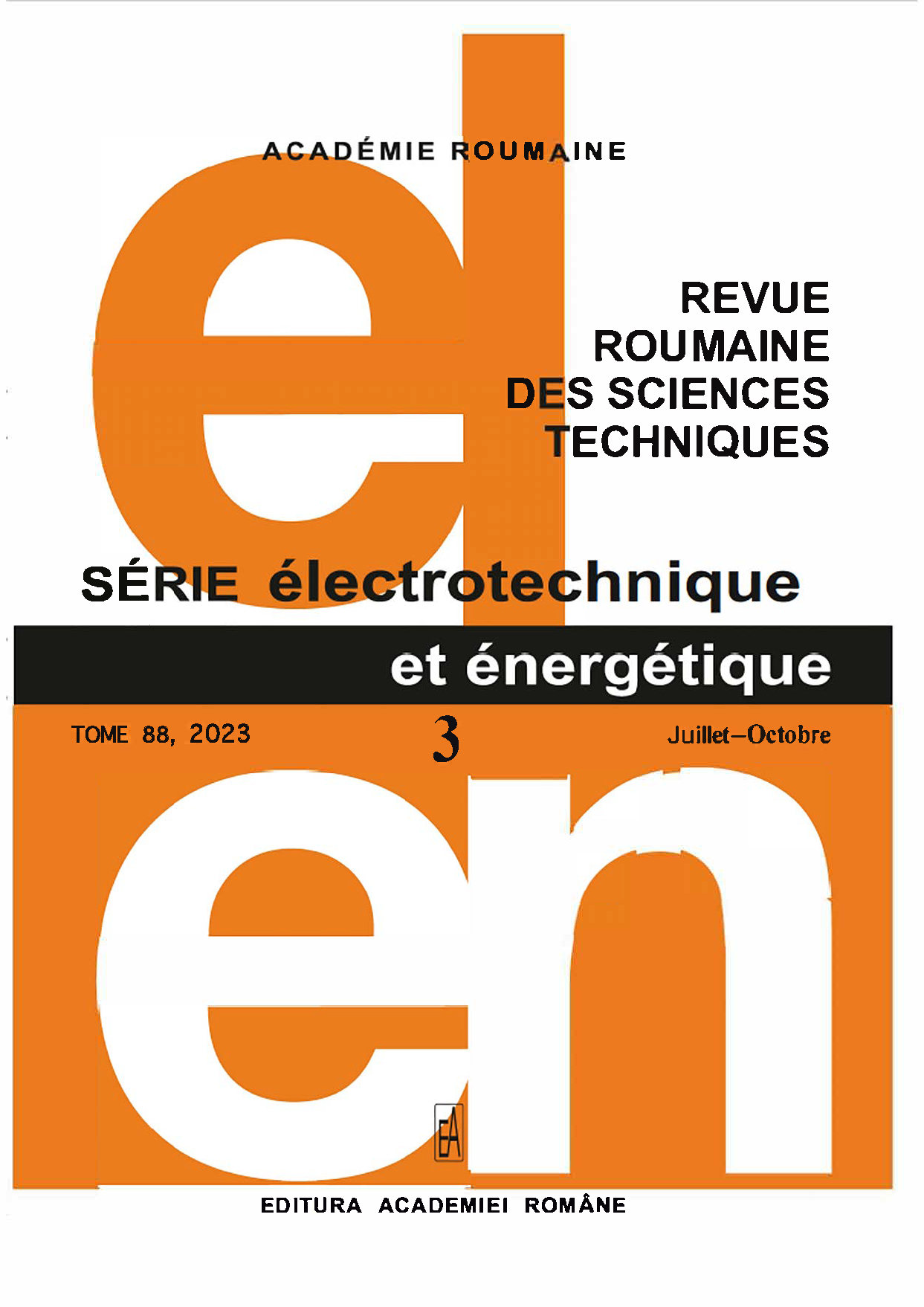FUZZY LOGIC CONTROLLED STATCOM WITH A SERIES COMPENSATED TRANSMISSION LINE ANALYSIS
DOI:
https://doi.org/10.59277/RRST-EE.2023.3.10Keywords:
Doubly fed induction generator, Sub-synchronous resonance, Static compensator, Static synchronous series compensator, Fuzzy logic controllerAbstract
The integration of wind farms with transmission networks exhibits several problems. The sub-synchronous resonance (SSR) plays a vital role in those issues, and it must be reduced. Two effective flexible ac transmission system (FACTS) based voltage control devices, namely static synchronous series compensator (SSSC) and static compensator (STATCOM) are proposed in this paper to mitigate the SSR. Detailed eigenvalue analysis was conducted to prove the successful mitigation of SSR by two controllers in a series of compensated wind farms. To find the dominant control scheme, the eigenvalues of the proposed controllers are compared with PSCAD/EMTDC simulations. Finally, a comparison study is carried out between the two proposed SSR controllers.
Further, the fuzzy logic control based on STATCOM and SSSC is also developed to enhance the stability margin of the wind turbine. The results have been validated with the IEEE 1st SSR benchmark system. From the results, it is proven that Fuzzy Logic Controller (FLC) based SSSC exhibits better performance than STATCOM.
References
(1) M.Q. Tran, M.C. Dinh, S.J. Lee, J.I. Lee, M. Park, C.H. Lee, J. Yoon, Analysis and mitigation of subsynchronous resonance in a Korean power network with the first TCSC installation, Energies, 12, 15, p. 2847 (2019).
(2) M.R. Shakarami, A. Asadi Ghyasvand, A. Kazemi, Evaluation of effect of SSSC stabilizer in different control channels on sub-synchronous resonance oscillations, Scientia Iranica, 25, 3, pp. 1492-1506 (2018).
(3) K. R. Dhenuvakonda, A. R. Singh, M. P. Thakre, B. S. Umre, A. Kumar, R. C. Bansal, Effect of SSSC‐based SSR controller on the performance of distance relay and adaptive approach using synchronized measurement, International Transactions on Electrical Energy Systems, 28, 11, pp. e2620 (2018).
(4) X. Zhu, M. Jin, X. Kong, J. Zhao, J. Liu, Q. Zhou, Subsynchronous resonance and its mitigation for power system with unified power flow controller, Journal of Modern Power Systems and Clean Energy, 6, 1, pp. 181-189 (2018).
(5) R. C. Mala, N. Prabhu, G. R. HV, Performance of STATCOM-ES in mitigating SSR, International Journal of Power Electronics and Drive Systems, 8, 4, pp. 1822 (2017).
(6) L. B. Shi, J. L. Su, L. Z. Yao, SS resonance analysis of complex power system incorporating wind power, IET Renewable Power Generation, 11, 3, pp. 305-312 (2017).
(7) A. Parida, D. Chatterjee, Integrated DFIG–SCIG‐based wind energy conversion system equipped with im-proved power generation capability, IET Generation, Transmission & Distribution, 11, 15, pp. 3791-3800 (2017).
(8) S. Arockiaraj, B. V. Manikandan, Novel transient stability analysis of grid connected hybrid wind/PV system using UPFC, The International Journal of Electrical Engineering & Education, pp. 1-19 (2021).
(9) D.K. Raju, B. S. Umre, M. P. Thakre, V. S. Kale, Mitigation of Subsynchronous oscillations with common controller based STACOM and SSSC, J. Electr. Eng. Elec-tron. Technol., 5, 1, pp. 735-744 (2016).
(10) A. Salemnia, M. Khederzadeh, A. Ghorbani, Mitigation of subsynchronous oscillations by 48-pulse VSC STATCOM using remote signal, 2009 IEEE Bucharest PowerTech, Bucharest, Romania, 28 June 2009 - 02 July 2009.
(11) S. Panda, A. K. Baliarsingh, S. Mahapatra, S. C. Swain, Supplementary damping controller design for SSSC to mitigate sub-synchronous resonance, Mechanical Systems and Signal Processing, 68, pp. 523-535 (2016).
(12) Y. Kailasa Gounder, D. Nanjundappan, V. Boominathan, Enhancement of transient stability of distribution system with SCIG and DFIG based wind farms using STATCOM, IET Renewable Power Generation, 10, 8, pp. 1171-1180 (2016).
(13) V. B. Virulkar, G. V. Gotmare, Sub-synchronous resonance in series compensated wind farm: A review, Renewable and Sustainable Energy Reviews, 55, pp. 1010-1029 (2016).
(14) A. A. Nafeh, A. Heikal, R. A. El-Sehiemy, W. A. Salem, Intelligent fuzzy-based controllers for voltage stability enhancement of AC-DC micro-grid with DSTATCOM. Alexandria Engineering Journal, 61, 3, pp. 2260-2293 (2022).
(15) O. Abdessemad, A. L. Nemmour, L. Louze, A novel control scheme implementation for a self-excited asynchronous generator. Revue Roumaine Des Sciences Techniques—Série Électrotechnique Et Énergétique, 67, 4, pp. 371-376 (2022).
(16) M. Gavrilas, R. Toma, Flexible Alternating Current Transmission System Optimisation In The Context Of Large Disturbance Voltage Stability. Revue Roumaine Des Sciences Techniques—Série Électrotechnique Et ÉnergétiquE, 66, 1, pp. 21-26 (2021).
Downloads
Published
Issue
Section
License
Copyright (c) 2023 REVUE ROUMAINE DES SCIENCES TECHNIQUES — SÉRIE ÉLECTROTECHNIQUE ET ÉNERGÉTIQUE

This work is licensed under a Creative Commons Attribution-NonCommercial-NoDerivatives 4.0 International License.


